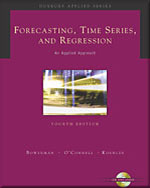| Date | Chapters/Sections | Topics covered | Remarks |
| January 6 | | Review | |
| January 11 | Chapter 2 | Basic Statistical Concepts | Rlab |
| January 13 | Chapter 2 | Confidence Interval; Hypothesis testing | |
| January 18 | No Class | MLK Day | |
| January 20 | Chapter 1 | An Introducion to Forecasting | |
| January 25 | Chapter 3 | Simple Linear Regression: Point Estimates and Point prediction | |
| January 27 | Chapter 3 | Simple Linear Regression: Confidence and Prediction Interval | |
| February 1 | Chapter 4 | Multiple Linear Regression | |
| February 3 | 4.3, 4.4,4.5 | Mean Square Error, Test of Significance, predicion Intervals | |
| February 8 | 4.6,4.7, 4.7, 4.8 | Quadratic Regression Model, Interaction | |
| February 10 | 4.9, Review | Qualitative Independent Variables | |
| February 15 | | Exam 1 | |
| February 17 | 5.1, 5.2 | Model Building, Multicollinearity, Residual Analysis | |
| February 22 | 5.3, 5.4 | Detecting outlying observation and Influential Observations | |
| February 24 | 6.1, 6.2 | Modeling Trend by Polynomial functions, Detecting Autocorrelation | Rlab |
| February 29- March 04 | | Break | |
| March 07 | 6.3, 6.4 | Seasonal variation | |
| March 09 | 6.5, 6.6 | First-Order Autocorrelation |
|
| March 14 | 7.1, 7.2 | Multiplicative Decomposition, Additive Decomposition | |
| March 16 | 7.3 | X-12-ARIMA Seasonal Adjustment Method | |
| March 21 | 8.1, 8.3 | Simple Exponential Smoothing | HW 5 Due |
| March 23 | 8.5, 8.6 | Holts Winters Method, Damped Trend and Other Exponential Smoothing Method | |
| March 28 | | Review | |
| March 30 | | Exam 2 | |
| April 4 | 9.1.9.2 | Stationary and non-stationary time series | |
| April 6 | 9.3, 9.4 | Nonseasonal Box-jenkins Models | |
| April 11 | Chapter 11* | Box-jenkins seasonal Modeling | |
| April 13 | | Review | |
| April 18 | | Review | |
| April 27 | | Final Exam (3:00AM- 6:00 PM) | |
